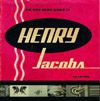 This CD/DVD set of Henry Jacobs'work has a lot to offer for anyone who decides to crack it openand spend a few hours exploring. The CD does amarvelous job of illustrating the breadth and variety of Jacobs' soundart, contained in 39 digestible little nuggets while the included DVD is also a fantastichistorical artifact, collecting all three episodes of a surrealtelevision show assembled in a free-associative manner.
This CD/DVD set of Henry Jacobs'work has a lot to offer for anyone who decides to crack it openand spend a few hours exploring. The CD does amarvelous job of illustrating the breadth and variety of Jacobs' soundart, contained in 39 digestible little nuggets while the included DVD is also a fantastichistorical artifact, collecting all three episodes of a surrealtelevision show assembled in a free-associative manner.
Important
Henry Jacobs was part of an explosively creative confluence of artistsand cultural pioneers that also included Ken Nordine, Alan Watts, LennyBruce and Allen Ginsburg, among others. This was San Francisco of the1950s and '60s, and Henry Jacobs was an avid sound recordist and musicalimproviser, and was in a unique position to document this scene. Jacobsalso hosted several radio shows, curated a number of experimentallabels releasing musique concrete records, and expanded his archive ofhis own sound art, field recordings, ethnic music loops and bizarrecomedy skits. This CD is drawn partially from Henry Jacobs' pastreleases (some of which have resurfaced on the Locust Music label), butlargely from a considerable stash of reel-to-reel tapes and 45sdiscovered hidden beneath a Mill Valley house a few years ago. The Wide Weird World of Henry Jacobs CDis a 54-minute journey through Jacobs' archive, selected and edited byJack Dangers, who is reportedly a big Henry Jacobs fan. This fantasticarchival package from Important Records also includes a DVD containingall three episodes of The Fine Art of Goofing Off, an experimental animated program that aired on San Francisco public television in 1972.
The CD serves two purposes, it seems. The first is for people who havenever heard the work of Henry Jacobs. The disc is brilliantlysequenced and never boring, cycling through a kaleidescopic array ofsound bites that are alternately funny, charmingly nostalgic, bizarre,psychedelic or inexplicable. From the odd verbal tennis of Jacobs andKen "Word Jazz" Nordine on tracks like "Cigarette Yoga," to asoft-spoken public radio DJ introducing the listening audience to the"new sounds of musique concrete," to the spooky psychedelic brainshivers of "Telephone Therapy," or the numerous excerpted bits of thewacky "Laughing String" sketch, listeners unfamiliar with Jacobs' workare in for a treat. Unlike more familiar works of tape collage fromthis period, Jacobs in unconcerned with formalism or overworking hissources too much. Instead, he seems to favor a more free-form approach,with an ear tuned towards less academic pursuits, and a musicalsensibility that seems to have been informed by exotica and cartoonsoundtracks, the radio landscape and early television. Because Jacobsexperienced the tail end of the beatnik movement, which quicklytransformed into proto-psychedelia, many of the sketches feel dated,satirizing then-current beatnik, mod and hipster cliches. That's alsopart of what makes the album feel charmingly analog and retro, notunlike the experience of listening to classic Firesign Theatre LPs, andoften just as hilarious.
The second purpose this CD serves is for Henry Jacobs enthusiasts,who will delight in hearing never-before-released recordings from thesame time period of his best work. Though this CD unquestionably fillsa void for new material from Jacobs, it also creates a lot ofquestions. Like, for instance, what happened to the rest of thematerial in that reportedly huge archive of tapes and LPs? Though itsgreat to hear this record, and the editing and sequencing arewonderful, I can't help but be really curious about what was left onthe cutting room floor. I suppose what we as listeners get from The Wide Weird Worldis not truly archival, but rather a highly subjective trip throughJacobs' discarded tape library. And while this doesn't reflectnegatively in any way on the people who put this collection together,I'd really like to hear the rest of the material, too. Releases likethis make me wish that the full, unexpurgated tapes will one day bereleased; I'd imagine that the entire library could fit on a couple ofDVDs, using the MP3 format.
Putting concerns like this aside, Wide Weird World is a greatset, and a great value as well. The TV programs on the included DVD were produced by Henry Jacobs,animator Bob McClay and producer Chris Koch. Strange audio cues ofvarious interviews and spoken-word bits set different primitiveanimations into motion, using a stream-of-consciousness editing styleto meditate, albeit very abstractly, on the subject of leisure andleisurely activities. Stop-motion claymation, experimental filmtechniques, Terry Gilliam-style cutouts, subliminal imagejuxtapositions and psychedelic animations complement an eclecticsoundtrack of music, jarring sound effects, and a series of narratorsruminating on leisure, delivering anecdotes and reading from funny"social engineering" pamphlets. It's undeniably reminiscent of earlyepisodes of Sesame Street in its attempt to marry the surreal andpsychedelic to family-friendly, educational programming. However, ittakes this concept several steps further out than Sesame Street or mosttelevision shows ever would or could, making it a very interestingshort-lived exploration of the more esoteric potentialities of themedium. I also have a feeling that the guys in Boards of Canada wouldreally cream their pants over these programs, as they share the oddlynostalgic patina and whimsicality of the '70s public educational filmworks that the duo adores so much.
samples:
Read More

